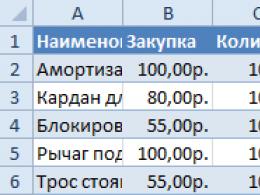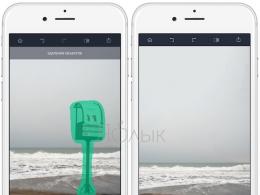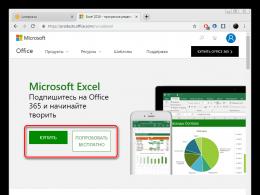Where is the google chrome browser menu. Hidden settings in the Google Chrome browser
This article contains detailed guide how to reset settings, configure plugins, bookmarks, start pages, search engine, and other features of Google Chrome. The guide will primarily be useful to people who are far from working with a computer and specifically this browser, but experienced users will also be able to learn something useful for themselves.
By default, Google Chrome is set to search using Google service. It is quite good and popular, but many users prefer competitors: Yandex, Bing, Mail.ru. In order to select a search engine, you need to go to the browser settings:
The changes will be automatically applied and saved to your profile. Now you can use search service Yandex directly in the address bar of Google Chrome.
Downloaded files
By default, the web browser saves files to system disk to the user's personal folder. If you are using multiple HDDs, it is recommended that you download content from the network to a media other than the one on which Windows is installed. Setting up a download folder is easy:

Homepage
The home site is the resource that you will be redirected to when you launch your browser. This may be a news site, Vkontakte or others. social media, a page with a list of your most visited sites, or just a tab with a search bar.
Open the settings, as in previous times. The required category is “On startup, open”. There are three items to choose from.

- New Tab - Opens a blank page with a search engine and a panel of your favorite resources.
- Previously opened tabs - will open all the pages that were open before the last shutdown of the browser.
- Preset pages - allows you to select a specific page homepage, for example, Vkontakte.
Plugins
Plugins, or extensions, are mini-programs that connect to Google Chrome and bring additional functions. This may be recognition of any formats, for example, FB2 or DJVU, built-in text editor, ad blocking management, child protection, additional tabs from Yandex and much more. Consider connecting an extension using the example of a plugin for advanced settings In contact with:
- As in previous times, go to the web browser settings.
- In the menu on the left, you need to select the item "Extensions" - it is located immediately above the settings item.

Now that the application is installed, it will appear in the list of installed ones, and you can use it at any time. Unnecessary plugins can be easily removed by clicking on the trash can icon to the right of the name. Almost all applications that can be installed on the Yandex browser will also go to Chrome, which makes it very easy to switch between these two programs.
Hidden settings
touch extra hidden google settings Chrome is only recommended for advanced users who know what they're doing. Ordinary people here may only need to enable NNAPI. Let's take a look at this topic as an example:

If you have accidentally turned on something that makes it difficult to work, the best solution is to reset the settings.
In order to make it more convenient to work with the Internet, you need to understand the capabilities of the browser. In this article, we will consider the main menu of the browser Google Chrome. This will allow you to understand in general terms what and where you can configure in order to at least know the direction of the search for optimization or the elimination of what interferes in the future. Moreover, with Google Chrome, not everything is as obvious as we say with Internet Explorer, which is Microsoft's primary browser.
In order to open the Main menu of the Google Chrome browser, you first need to find it. It is located in a tricky place: at the end of the address bar and opens by left-clicking on the three vertical dots icon:
Contents of the Main Menu of the Google Chrome Browser
Let's see what items the main menu of the Google Chrome browser consists of:
Working with windows and tabs:
- « New tab» - Creates new tab in the browser (hot keys Ctrl+T)
- « New window» - Creates a new browser window (shortcut Ctrl+N)
- « New incognito window» - Creates a new browser window in incognito mode (hot keys Ctrl+Shift+N)
Working with browsing history, downloads and bookmarks:
- « History» - a composite menu item. Opens the history of visited pages (hot keys Ctrl+H)
- « Downloads"- opens a window for working with downloaded files (hot keys Ctrl + J)
- « Bookmarks» - a composite menu item. To work with browser bookmarks.
Working with the scale of the displayed page:
- « Scale» - allows you to scale the displayed page, and also opens the full-screen display mode.
Working with the page and external devices:
- « Seal..."- opens the dialog box for preparing the page for printing (hot keys Ctrl + P)
- « Broadcast...» - opens the dialog box for preparing the page for translation on external devices(e.g. TV)
- « To find..."- opens the text input field to search for it on the page (hot keys Ctrl+F)
- « Additional tools...» - a composite menu item. To save the page and work on debugging it.
Working with page content:
- « Change»
- « Cut»
- « Copy»
- « Insert»
Browser settings and help:
- « Setting» - opens the browser settings for viewing and changing them
- « reference» - opens a page with instructions and tips on how to work with the browser.
Output:
- « Output" - closes the browser window. (hot keys Ctrl+Shift+Q)
Google Chrome is a powerful and functional web browser that has in its arsenal a lot of features for fine tuning. However, not all users know that the "Settings" section contains only a small part of the tools for working on improving the browser, because there are also hidden settings, which will be discussed in the article.
Many web browser updates add new features and functionality to Google Chrome. However, such functions appear in it far from immediately - at first they long time are tested by everyone, and access to them can be obtained in hidden settings.
Thus, hidden settings are Google Chrome test settings, which are currently under development, and therefore can be very unstable. Some options may suddenly disappear from the browser at any time, and some remain in the hidden menu without getting into the main one.
Getting into the hidden settings of Google Chrome is quite simple: to do this, using the address bar, you need to go to the following link:
chrome://flags
The screen will display a list of hidden settings, which is quite extensive.

Pay attention to the fact that mindlessly changing the settings in this menu strongly discouraged as it can seriously disrupt the browser.
How to use hidden settings
Activation of hidden settings, as a rule, occurs by pressing the button next to the required item. "Turn on" . Knowing the name of the parameter, the easiest way to find it is using the search bar, which can be called using a keyboard shortcut ctrl+f .

For the changes to take effect, you will definitely need to restart the web browser by agreeing with the program's suggestion or by performing this procedure yourself.

Below we will consider a list of the most interesting and relevant Google Chrome hidden settings for the current day, with which the use of this product will become even more comfortable.
5 Hidden Tweaks to Improve Google Chrome
1. "Smooth Scrolling". This mode allows you to smoothly scroll the page with the mouse wheel, greatly improving the quality of web surfing.

2. "Quick closing tabs / windows." Useful feature, which allows you to increase the response time of the browser for almost instantaneous closing of windows and tabs.

3. "Automatically delete the contents of the tabs." Prior to the adoption of this feature, Google Chrome consumed a huge amount of resources, and also spent significantly more battery power due to this, and therefore users of laptops and tablets refused this web browser. Now everything is much better: by activating this function, when the memory is full, the contents of the tab will be erased, but the tab itself will remain in its place. Opening the tab again will reload the page.

4. " material design at the top Chrome browser" and "Material Design in the rest of the browser interface". Allows you to activate one of the most successful designs in the browser, which has been improved in Android OS and other Google services for several years.

5. "Creating passwords." Due to the fact that each Internet user registers on more than one web resource, special attention should be paid to the strength of passwords. This function will allow the browser to automatically generate strong passwords for you and automatically save them in the system (passwords are securely encrypted, so you can be calm about their safety).

We hope this article was helpful to you.
For normal work in the browser, you must first configure it. Initially, the browser, and in this article we will talk about Google Chrome, is configured for most users in the same way. The settings include many features that allow you to improve the browser, as Google conducts continuous statistics and data collection. Not all users like this collection. After all, only company employees know exactly what data is sent by the browser about the user and his activities on the Web and what happens to them then.
One of the famous browsers is Google Chrome. How to configure it so that further work does not bring inconvenience? Very simple. In the settings, we will turn off everything that can confuse or alert us, go through all the settings and make the browser work as comfortable as possible.
What is a browser
This is an application that allows you to visit the pages of sites, view any content. A program that allows you to watch videos directly in your browser, download any interesting information and much more. There is simply an immense flow of information on the Web, and our goal is to protect ourselves, our computer and our data from intruders in the Google Chrome browser. How to configure it so that they cannot get into the computer and harm us? In the article you will find the answer to this question.
If you do not know how to set up the Google Chrome browser, then let's get started. After downloading and installing, opening the browser for the first time, you will see a simple window (photo below). In the center is the Google logo, the search bar, and above address bar, where earlier it was necessary to write URL requests, but now it is already the so-called smart string, which allows you to write there not only the exact address of the site, but simply any queries, and the search will be performed in the search engine. But more on that later.

Below search string tiles quick access, they are still empty, but when you visit various sites, the last visited pages will be displayed there, which is very convenient.
Now let's go to settings.
We click on the button in the form of three horizontally located dots, it will open context menu, in which we are interested in the "Settings" item.

Next, you will see a window in which we will need to make changes to Google Chrome. How to configure the browser to work as efficiently as possible without causing inconvenience to the user? The main thing is to carefully read the description of the settings menu items and not be afraid to switch them. In any case, you can always return the initial state browser.
More details on the points
- In the first paragraph, we can synchronize our account in Chrome, thereby connecting Google Chrome browsers on other devices to our account.

- Customize what exactly will open when the browser starts: a new page, a site, or previously opened tabs.
- Here you can select a theme, if necessary, check the item “Always show the bookmarks bar”, since there are several ways to set up bookmarks in Google Chrome. In this case, this panel will appear below the smart bar.
- Decide on a search engine. Here if you don't like it search system Google, you can switch it to another one - Yandex, Bing or Mail. At your discretion.
- Next, we can import bookmarks and settings from another browser to Google Chrome. How to set up - add, change or delete a user, as well as assign him an avatar from the proposed list? Here you can do it.
- At the very bottom of the page, we need to click on the link "Show more settings".
- Next, you have the option to customize the content, clear the history, check or uncheck the checkboxes for sending automatic statistics, device protection and enable hints, check the "Remember passwords" checkbox, and select the page scale.
- If necessary, you can configure proxy servers.
- Change language settings.
- Specify the path to download files. Check the box next to "Always specify a location for downloading files". Then, with each download, a window will open in the browser asking you to select a partition on your hard drive to save files. IN otherwise downloaded files will be saved in the "Downloads" folder on the system drive.
- Set up certificates and virtual printer.
- At the bottom last point there is a reset button. If the result does not suit you, you can always restore standard settings using this button. And your bookmarks will be saved. But the settings will be reset to default.

Quick access settings
Exit and again click on the button "Configure and manage Google Chrome". Here we see other sections.
- Here you can set up Google Chrome tabs - open the page in a new tab or a new window.
- The browser has the ability to open a window in incognito mode, this mode leaves no traces, does not save file history. Actual if you need to enter the office from someone else's computer.
- Section with settings for bookmarks, downloads and history.
- And also here you can change the scale of the browser page.
- Print the page or save it as a PDF.

Customize your browser
In the "Additional tools" section, you can install, download, remove various add-ons and extensions to the browser. A huge number of interesting extensions can be downloaded by clicking on the "More extensions" button. There are many in the Google Chrome store free extensions, themes, applications and games that can be downloaded in one click.
But be careful, not all of them are safe, before downloading an unknown extension or theme, go to the official website of a particular plugin and read the reviews. It is not uncommon for infected plug-ins to get onto a computer through a browser malware and bring PC owners a lot of trouble.






